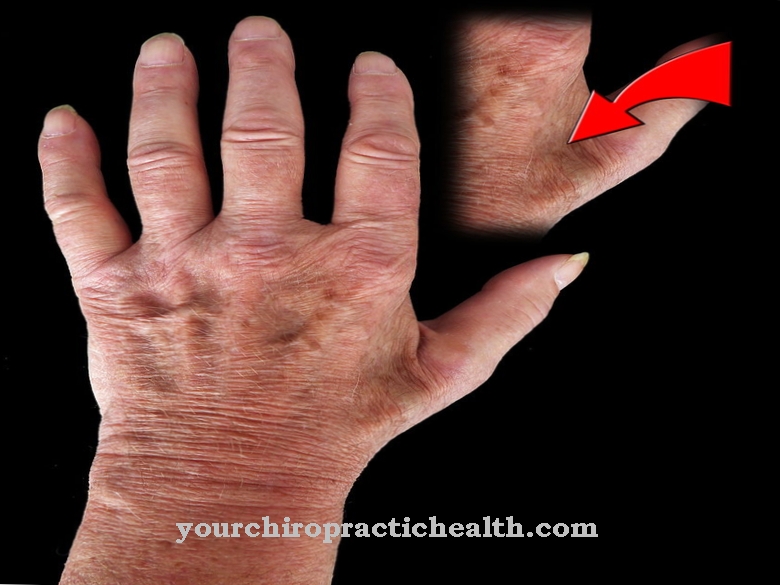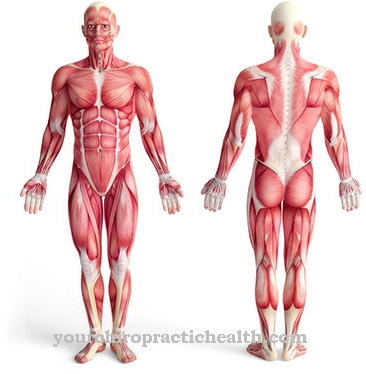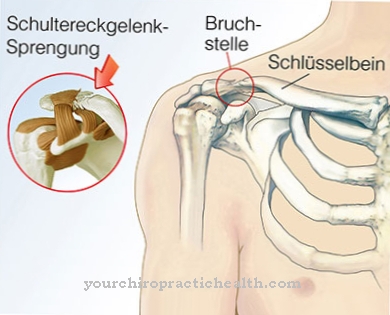At Hyperostoses the bone tissue increases. This is mostly due to an increased activity of the osteoblasts. In addition to a curettage, drug treatment options are now also available for treatment.
What is hyperostosis?

© PiyawatNandeenoparit - stock.adobe.com
In hyperplasia, a tissue or organ enlarges by increasing its number of cells. This increase in the number of cells is usually a reaction to functionally increased stress or hormonal stimulation. Hyperplasias are reversible. As soon as the causative stimulus is removed, the affected tissue normalizes.
Depending on the type of tissue affected, there are different subgroups of hyperplasia. The Hyperostosis corresponds to hyperplasia of bone tissue. The phenomenon produces excessive excess bone tissue. The so-called osteoblasts are responsible for the formation of bone tissue. Their excessive activity is also the basis of the pathological increase in bone substance in the sense of hyperostosis.
Hyperostosis is also known as bone hypertrophy or bone hyperplasia. Bone hypertrophy, as distinct from hyperplasia, is not caused by cell proliferation, but by an increase in the size of the individual cells. Hyperostosis is either inward or outward. The former is also referred to as endosteal hyperostosis.
The outward direction describes the term exostosis or cortical hyperostosis. In its narrower definition, the term hyperostosis describes a bone disease that is characterized by an increase in bone density and thus primarily affects the ratio of bone mass to bone volume.
causes
All hyperostoses are caused by an increased activity of the bone-forming osteoblasts. The increased activity results in either a compression of the bone mass or appositional bone growth. The latter phenomenon in particular results in a change in shape and size of the affected bone.
Even if the function of the bone-degrading osteoclasts is disturbed, hyperostoses can result. Human bone mass is affected throughout life by remodeling work, which consists of an interplay of bone formers and osteoclasts. So if the interplay gets out of whack, hyperostoses are conceivable.
One of the main triggers for increased bone formation is hormonal irritation or particular stress on a bone. This creates locally limited hyperostoses. A hormonal imbalance can play a role in this context. Apart from that, metabolic disorders such as the consequences of chronic kidney failure can be causally involved in increased bone formation.
In addition, poisoning with fluorides, lead, vitamin A, bismuth, arsenic, strontium, phosphorus or beryllium can play a role. Changes in the activity of the bone cells are also based on hereditary diseases such as juvenile Paget's disease, [Van Buchem syndrome]] or osteopetrosis, with mutations being the original trigger in this context.
In addition, causes such as rheumatoid diseases in the sense of SAPHO syndrome or Forestier's disease are conceivable triggers. In addition, chronic infections such as tuberculosis, tumors such as meningiomas and paraneoplastic syndromes in the context of pachydermoperiostosis of bronchial carcinoma can be the cause.
Symptoms, ailments & signs
Patients with hyperostosis suffer from an increased build-up of bone tissue, which is characterized by an increased activity of the osteoblasts and can be associated with a decreased activity of the osteoclasts. With moderate hyperostosis, there is usually no severe pain.
However, severe hyperostosis can be accompanied by pain. If the affected bone is involved in articulated connections, for example, then movement disorders or other deficits can arise as a result of the increase in size. All other symptoms of hyperostosis depend on the affected area of the body and, above all, on the primary cause of the disease.
In the case of hormonal disorders, hyperostosis is accompanied by an imbalance in the hormonal balance, which can have completely different effects depending on the hormones involved. Causes of the rheumatoid form are usually associated with severe pain conditions, which can cause the affected person to become unable to move due to pain at regular intervals.
In the case of causative infections, the accompanying symptoms usually correspond to general signs of infection such as fever, chills, fatigue or similar symptoms. When hyperostosis has a hereditary basis, the abnormal activity usually exists from birth, often affecting all of the bones in the body.
Diagnosis & course of disease
The diagnosis of hyperostosis is made with the help of imaging methods such as X-ray imaging or MRI. A biopsy of the affected tissue can confirm the suspected diagnosis. Values such as calcium are primarily determined in laboratory chemistry. Since hyperostosis is only the symptom of a general disease, the diagnosis includes the clarification of the primary cause.
Complications
The hyperostosis does not necessarily have to lead to pain or other unpleasant symptoms. The resulting complications depend in most cases on the severity of the disease, which is why no general prediction is possible. If the bone spreads too much, it can lead to pain and thus to restricted mobility.
These restrictions lead to psychological complaints and sometimes to depression in many patients. However, they can be treated relatively well with the help of a psychologist. Furthermore, there is an unbalanced hormone balance. Here, too, there are various complaints that depend on the respective hormone deficits. Usually the patients also suffer from chills and a severe fever.
The patient's resilience drops enormously and those affected no longer actively participate in life. The patient continues to feel exhausted. The quality of life is extremely reduced by the complaints. There are no further complications or complaints when treating hyperostosis. In most cases, however, a bone marrow transplant is necessary to alleviate the symptoms. Life expectancy is usually not reduced by hyperostosis.
When should you go to the doctor?
If you notice unusually severe pain over a long period of time, you should consult a doctor. Hyperostosis is also manifested by increasing movement disorders and unspecific feelings of pressure in the area of the bones - these must also be clarified quickly. If other complaints arise, medical advice is required. Any accompanying symptoms such as fever, chills or fatigue must be examined and, if necessary, treated if they persist for more than two to three days.
If there are other symptoms of a serious illness, medical advice must be obtained on the same day. People with a hormonal imbalance or metabolic disorders are particularly at risk. Chronic kidney failure and poisoning are also possible triggers. People who belong to these risk groups should see their family doctor with the symptoms mentioned. Further contact persons are specialists in internal medicine or an orthopedist. In the event of severe complaints, you can first contact the emergency medical service, which will recommend further measures. If in doubt, a visit to the hospital is indicated.
Doctors & therapists in your area
Treatment & Therapy
Treatment of hyperostosis depends on the primary cause and pattern of involvement. Depending on this, the therapy can encompass surgical, orthopedic or neurosurgical interventions. In addition to invasive procedures, conservative drug treatment procedures are available.
With the administration of calcitriol, for example, the activity of the bone-degrading osteoclasts can be increased. In addition, allogeneic bone marrow transplantation can stimulate the resorption of bone tissue. The invasive treatment options also include curettage, in which the bone is surgically removed.
Nonetheless, the treatment of the underlying disease is the focus of the therapy in the case of hyperostosis, as permanent normalization of the bone tissue can only be achieved with an improvement or healing of the cause.Mutational underlying diseases cannot be cured, but in most cases they can be mitigated and delayed. Above all, this prevents the progression of hyperostosis.
In the case of causal disturbances in the hormonal balance, hormonal substitution can under certain circumstances stimulate the activity of the osteoclasts and down-regulate the osteoblastic activity. In the case of poisoning, the aim should be to discharge the toxins, which is mainly brought about by diuresis. In this case, the focus is on supporting the kidney function.
You can find your medication here
➔ Medicines for painOutlook & forecast
The prognosis of an existing hyperostosis depends on the respective cause. Acromegaly (gigantism), exostosis or endostosis can occur.
In the growing skeleton, an excess formation of bone tissue leads not only to an increase in bone thickness but also to increased length. In addition to the enlargement of the hands, feet, chin, nose and ears (acromegaly), there is also increased growth up to gigantic stature. There are also forms of hyperostosis associated with short stature. As part of an exostosis, permanent outgrowths form on the bone surface. Exostosis leads to deformation of the bones, restricted mobility and pain. Nerve compressions are also possible. Asymptomatic courses, apart from minor bone deformations, can also occur. The bone can also grow inwards (endostosis) and thereby narrow the medullary canal. Often the bone mass thickens (osteosclerosis).
Hyperostosis occurs very often in the context of certain hereditary diseases. In these cases a cure is not possible. After the removal of exostoses, the results are often unsatisfactory because recurrences often develop. Generalized osteosclerosis is often found in hereditary underlying diseases. This means that there is a compression of the bone mass on the entire skeleton. However, there are also diseases with local osteosclerosis. This occurs in both benign and malignant bone tumors.
prevention
Hyperostosis can have innumerable causes. Not all, but individual causes can be prevented. One of the prophylactic steps is avoiding local irritation caused by overload.
Aftercare
In the case of hyperostosis, the person affected has only very limited options and measures for follow-up care. First and foremost, a quick and, above all, early diagnosis must be made so that there are no further complications or complaints. The earlier the disease is recognized, the better the further course is usually. No general prediction can be made about the further course or life expectancy of the person affected.
The disease is usually treated with the help of medicines. The patient must pay attention to the correct intake and the correct dosage. If you have any questions or are unclear, you should always consult a doctor first. A doctor should also be contacted first in the event of interactions or side effects. As a rule, the underlying disease must first be treated correctly in order to completely alleviate the symptoms of hyperostosis.
During treatment, the patient's internal organs should be checked regularly to prevent further damage. Above all, the kidneys must be checked regularly. In some cases, however, a surgical procedure is necessary, after which the person concerned must rest in any case.
You can do that yourself
Hyperostosis is a serious disease that is often associated with chronic complaints. Which self-help measures those affected can take depends on how far the causal disease has progressed and which symptoms are showing.
In principle, individual measures can be taken against the individual symptoms. If you have a fever and chills, bed rest and rest are recommended. In addition, the person concerned should pay attention to a gentle diet and monitor their body temperature. If the fever rises above 40 degrees, a doctor must be consulted. Fatigue and exhaustion can be relieved using various homeopathic remedies, for example belladonna and devil's claw. Acute help moist compresses and moderate exercise.
If this does not reduce the symptoms, medical advice is required. Exercise and a change in diet also help with hormonal disorders. However, if there is pain, drugs must be used. The medicinal preparations can possibly be supplemented with natural remedies such as St. John's wort or marigold ointment, provided the doctor gives his consent. In addition to the measures mentioned, a close medical check-up is always indicated to ensure that the disease progresses positively.

.jpg)























.jpg)


